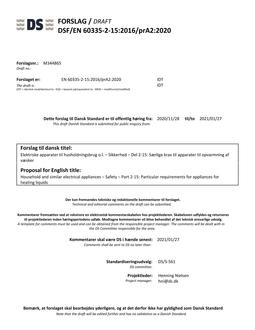-
-
Available Formats
- Availability
- Priced From ( in USD )
-
Available Formats
-
- Immediate download
- $145.05
- Add to Cart
-
- Printed Edition
- Ships in 1-2 business days
- $145.05
- Add to Cart
Customers Who Bought This Also Bought
-

DANSK DS/ISO/TS 19567-2
Priced From $76.27 -

DANSK DSF/EN 60335-2-15/PRA2
Priced From $18.25 -

DANSK DS/EN 13418
Priced From $145.05
About This Item
Full Description
The present document specifies technical characteristics and methods of measurements for the following equipment types: 1) Non specific Short Range Devices, including alarms, telecommand, telemetry, data transmission in general, etc. 2) Radio Frequency IDentification (RFID) devices. 3) Radiodetermination devices including detection, movement and alert applications. These radio equipment types are capable of operating in the permitted frequency bands within the 1 GHz to 40 GHz range as specified in table 1: 1) with either a Radio Frequency (RF) output connection and dedicated antenna or an integral antenna; 2) for all types of modulation; 3) with or without speech. Table 1 shows a list of the frequency bands as designated by the European Commission Decisions on Short Range Devices [i.5] and the CEPT/ERC Recommendation 70-03 [i.2] as known at the date of publication of the present document. Table 1: Short Range Devices within the 1 GHz to 40 GHz permitted frequency bands Frequency Bands Applications Notes Transmit and Receive 2 400 MHz to 2 483,5 MHz Non-specific short range devices Transmit and Receive 2 400 MHz to 2 483,5 MHz Radio determination devices Transmit and Receive (a) 2 446 MHz to 2 454 MHz Radio Frequency Identification (RFID) devices See annex D Transmit and Receive (b) 2 446 MHz to 2 454 MHz Radio Frequency Identification (RFID) devices See annex D Transmit and Receive 5 725 MHz to 5 875 MHz Non-specific short range devices Transmit and Receive 9 200 MHz to 9 500 MHz Radio determination devices Transmit and Receive 9 500 MHz to 9 975 MHz Radio determination devices Transmit and Receive 10,5 GHz to 10,6 GHz Radio determination devices Transmit and Receive 13,46 GHz to 14,0 GHz Radio determination devices Transmit and Receive 17,1 GHz to 17,3 GHz Radio determination devices See annex F Transmit and Receive 24,00 GHz to 24,25 GHz Non-specific short range devices and Radio determination devices NOTE: (a) and (b) refer to two different operational restrictions for different power levels in the same frequency band. NOTE 1: Table 1 represents the most widely implemented position within the European Union [i.5] and the CEPT NOTE 2: In addition, it should be noted that other frequency bands may be available in a country within the frequency range 1 GHz to 40 GHz covered by the present document. See the European Commission Decisions on Short Range Devices [i.5] and the CEPT ERC Recommendation 70-03 [i.2] as implemented through National Radio Interfaces (NRI) and additional NRI as relevant. NOTE 3: On non-harmonised parameters, national administrations may impose certain conditions such as the type of modulation, frequency, channel/frequency separations, maximum transmitter radiated power, duty cycle, and the inclusion of an automatic transmitter shut-off facility, as a condition for the issue of an individual or general licence, or as a condition for the issuing of Individual Rights for use of spectrum or General Authorization, or as a condition for use "under licence exemption" as it is in most cases for Short Range Devices. The present document covers fixed stations, mobile stations and portable stations. Applications using Ultra Wide Band (UWB) technology are not covered by the present document. The present document covers the essential requirements of article 3.2 of Directive 2014/53/EU [i.6] under the conditions identified in annex A.
Amendments, rulings, supplements, and errata
-
DANSK DSF/EN 300 440 V2.2.0 (2017-09)
Short Range Devices (SRD)- Radio equipment to be used in the 1 GHz to 40 GHz frequency range – Harmonised Standard for access to radio spectrum -
DANSK DS/EN 300 440 V2.2.1
Short Range Devices (SRD); Radio equipment to be used in the 1 GHz to 40 GHz frequency range; Harmonised Standard for access to radio spectrum




